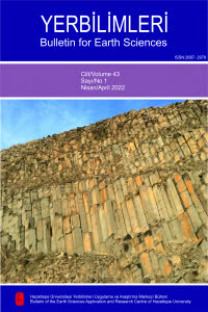Örnek mikro yapısının ve köşeliliğinin suda dağılmaya karşı duraylılık indeksine etkisi ve suda dağılmaya duraylılık indeksiyle bazı fiziksel özellikler arasındaki ilişki
The effect of micro-structure and angularity of aggregates on the slake durability index and the relationship between the slake durability index and some physical properties
___
- ASTM, 1990. Standard test method for slake slake durability of shales and similar weak rocks (D4644). Annual Book of ASTM Standards Vol. 4. 08. ASTM, Philadelphia, PA. 863-865.
- Aufmuth, R.E., 1974. Site engineering indexing of rocks: Field testing and instrumentation of rock. American Society for Testing and Materials, Special Technical Publication, 554, 81-99.
- Aydan, O., and Ulusay, R., 2003. Geotechnical and geoenvironmental characteristics of man-made underground structures in Cappadocia, Turkey. Engineering Geology, 69, 245-272.
- Bayhan, E., Temel, A., Şahbaz, A., Varol, B., Kazancı, N., Görmüş, S. ve Ergin, M., 1998. Mudanya-Ulubat Gölü (Bursa Yöresi) Orta-Üst Miyosen-Kuvaterner istifinin mineralojik incelenmesi. Yerbilimleri, 20, 55-62.
- Bell, F.G., Entwisle, D.C., and Culshaw, M.G., 1997. A geotechnnical survey of some British Coal Measures mudstones, with particular emphasis on durability. Engineering Geology, 46, 115-129.
- Çetin, H., Laman, M., and Ertunç, A., 2000. Settlement"and slaking problems in the world's fourth largest rock-fill dam, the Atatürk Dam in Turkey. Engineering Geology, 56, 225-242.
- Dhakal, G., Yoneda, T., Kato, M., and Kaneko, K., 2002. Slake durability and mineralo-gical properties of some pyroclastic and sedimentary rocks. Engineering Geology, 65, 31-34
- Franklin, J.A., and Chandra, R., 1972. The slake durability test. International Journal of Rock Mechanics and Mining Sciences, 9,-325-341.
- Gamble, J.C., 1971. Durability-plasticity classification of shales and other argillaceous rocks. PhD Thesis, University of Illinois (yayımlanmamış).
- Gökçeoğlu, C, Ulusay, R., and Sönmez., H., 2000. Factor effecting the durability of selected weak and clay-bearing rocks from Turkey, with particular emphasis on the influence of the number of drying and wetting cycles. Engineering Geology, 57, 215-237.
- Golden Software, 2000. Didger 2.0, Golden Software Inc.,USA.
- ISRM, 2007. The Complete IŞRM Suggested Methods for Rock Characterization, Testing and Monitoring: 1974-2006. R.. Ulusay and J.A. Hudson (eds.), Ankara.
- Kayabalı, K., Beyaz., T., and Kolay, E., 2006. The effect of the ph of the testing liquid on the slake durability of gypsum. Bulletin of Engineering Geology and the Environment, 65, 65-71.
- Ketin, L, 1955. Yozgat bölgesinin jeolojisi ve Orta Anadolu masifinin tektonik durumu. Türkiye Jeoloji Kurumu Bülteni, 6, 1-40.
- Kolay, E. ve Kayabalı, K,, 2005. Agregaların köşeliliğinin ve pürüzlülüğünün belirlenmesinde fractal boyut yönteminin kullanılması. Yerbilimleri, 26 (2), 49-61.
- Kolay, E., and Kayabalı, K., 2006. Investigation of the effect of aggregate shape and surface roughness on the slake durability index using the fractal dimension approach. Engineering Geology, 86, 271-284.
- Koncagül, E., and Santi, P.M., 1998. Predicting the unconfined compressive strength of the Breathitt shale using slake durability, Shore hardness and rock structural properties. International Journal of Rock Mechanics and Mining Sciences, 36, 139-153.
- Mandelbrot, B.B., 1967. How long is the coast of Great Britain: Statical self similarity and the fractional dimension. Science, 156,636-638.
- Moon, V.G., and Beattie, A.G., 1995. Textural and microstructural influences on the durability of Waikato coal measures mudrocks. Quarterly Journal of Engineering Geology, 28, 303-312.
- MTA, 1997. Türkiye jeoloji haritaları. Maden Tetkik Arama Enstitüsü, 55. Ankara F15 paftası.
- Taylor, R.K., 1988. Coal Measures mudrocks: composition, classification and weathering processes. Quarterly Journal of Engineering Geology. 21, 85-99.
- Temel, A,, i 992. Kapadokya eksplozif volkanizmasının petrolojik ve jeokimyasal özellikleri. Doktora Tezi, Jeoloji Mühendisliği Bölümü, Hacettepe Üniversitesi (yayımlanmamış).
- Ulusay, R., Arıkan,F., Yoleri, M.F., and Çağlayan, D., 1995. Engineering geological characterization of coal mine waste material and evaluation in the context of back-analysis of spoil pile instabilities in a strip mine SW Turkey. Engineering Geology, 40, 77-101.
- Vallejo, L.E., 1994. Fractal analysis of the slake durability test. Canadian Geotechnical Journal, 31, 1003-1008.
- Yılmaz, I., and Karacan, E., 2005. Slaking durability and its effect on the Doline formation in the gypsum. Environmental Geology, 47, 1010-1016.
- ISSN: 1301-2894
- Yayın Aralığı: 3
- Başlangıç: 1976
- Yayıncı: Hacettepe Üniversitesi Yerbilimleri Uygulama ve Araştırma Merkezi
Siyah Aladağ napı'nın stratigrafik ve tektonik özellikleri (Aladağlar, Doğu Toroslar)
Ö. Faruk ÇELİK, Nazif DEMİR, ALPER GÜRBÜZ, Ergüzer BİNGÖL
Ş. Can GENÇ, ŞAFAK ALTUNKAYNAK
Siyah Aladağ Napının stratigrafik ve tektonik özellikleri (Aladağlar, Doğu Toroslar)
